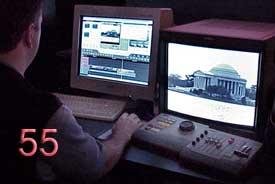|
Module 55 |
Updated: 08/30/2005
|
|
Editing Part II In this module we'll cover the final editing guidelines. Guideline number 4: Cut away from the scene the moment the visual statement is made. First, a personal observation. From the perspective of having taught video production for more than two decades I can say that more than 90% of the videos I see from students are too long. Most could have been vastly improved by being edited down-often by at least 50%. When I tell students this they seem skeptical until I show them sample scenes from commercials, dramatic productions, news segments, and resume reels from noted professionals. If you ask someone if he or she enjoyed a movie and they reply,
"Well, it was kind of slow," that will probably be a movie you will avoid. "Slow
moving" connotes boring. In today's fast-paced and highly competitive film and television
fields that's one thing you don't want to be if you want to stay in the business.
|
|
The pace of a production rests largely with the editing, although the best editing in the world won't save bad acting or a script that is boring to start with. So how long should scenes be? First, keep in mind that audience interest quickly wanes once the essential visual information is conveyed. Shots with new information stimulate viewer interest. In this regard there are some additional points that should
be considered. New vs. Familiar Subject Matter Shot length is in part dictated by the complexity and familiarity of the subject matter. How long does it take for a viewer to see the key elements in
a scene? Can they be grasped in a second (take a look at some contemporary commercials),
or does the subject You wouldn't need a 15-second shot of the Statue of Liberty, because we've all seen it many times. A one- or two-second shot would be all you would need to remind viewers of the symbolism (unless, of course you were pointing out specific areas of damage, restoration, or whatever). On the other hand, we wouldn't appreciate
a one or two second shot of a little green Martian who just stepped out of a flying
saucer on the White House Lawn. Those of us who haven't seen these space creatures
would want plenty of (scene) time to see what one really looks like. In an earlier module we mentioned montage editing. With this technique shots may be only a fraction of a second (10-15 video frames) long. Obviously, this is not enough time even to begin to see all of the elements in the scene. The idea in this case is simply to communicate general impressions, not details. Commercials often use this technique to communicate such things as excitement or "good times." Next, cutting rate depends on the nature
of the production content. For example, tranquil pastoral scenes imply longer shots
than scenes of rush hour in downtown New York. You can increase production tempo
by making quick cuts during rapid action. Varying Tempo Through Editing A constant fast pace will tire an audience; a constant slow pace will induce them to look for something more engaging on another channel. If the content of the production doesn't have natural swings
in tempo, the editor, with possible help from music, should edit segments together
to create changes in pace. This is one of the reasons that editors like parallel
stories in a dramatic production-pace and content can be varied by cutting back
and forth between stories. How you start a production is critical, especially in commercial television. If you start out slow (and boring), your audience will probably immediately go elsewhere. Remember, it's during these opening seconds that viewers are most tempted to "channel hop" and see what else is on. Because the very beginning is so important, TV programs often show the most dramatic highlights of the night's program right at the start. To hold an audience through commercials, newscasts regularly "tease" upcoming stories just before commercial breaks. So, try to start out with segments that are strong-segments that will "hook" your audience. But, once you have their attention, you have to hold onto it. If the action or content peaks too soon and the rest of the production goes down hill, you may also lose your audience. It's often best to open with a strong audio or video statement and then fill in needed information as you go along. In the process, try to gradually build interest until it peaks at the end. A strong ending will leave the audience with positive feelings about the program or video segment. To test their productions, directors sometimes use special preview sessions to try out their productions on general audiences. They will then watch an audience's reaction throughout a production to see if and exactly where attention drifts. Guideline number 5: Emphasize the B-Roll. Howard Hawks, an eminent American film maker, said: "A great movie is made with cutaways and inserts." We've previously noted that in video production these commonly go under the heading of "B-roll footage." In a dramatic production the B-roll might consist of relevant details (insert shots and cutaway shots) that add interest and information. One valuable type of cutaway, especially in dramatic productions, are reaction shots - close-ups showing how others are responding to what's gong on. Sometimes this is more telling than holding a shot of the person speaking. For example would you rather see a shot of the reporter or the person being interviewed when the reporter springs the question: "Is it true that you were caught embezzling a million dollars?" The do's and don'ts of interviewing can be By using strong supplementary footage the amount of information conveyed in a given interval increases. More information in a shorter time results in an apparent increase in production tempo. The A-roll in news and interviews typically consists of a rather static looking "talking head." In this case the B-roll would consist of scenes that support, accentuate, or in some way visually elaborate on what's being said. For example, in doing an interview with an inventor who has just perfected a perpetual-motion machine, we would expect to see his creation in as much detail as possible, and maybe even the workshop where it was built. Given the shortage of perpetual motion machines, this B-roll footage would be more important to see than the A-roll (talking head) interview footage. Guideline number 6: The final editing guideline is: If in doubt, leave It out. If you don't think that a scene adds needed information, leave
it out. By including it, you For example, a TV evangelist paid tens of thousands of dollars to buy network time. He tried to make his message as engrossing, dramatic, and inspiring as possible. But, during the message the director saw fit to cutaway to shots of cute, fidgety kids, couples holding hands, and other "interesting" things going on in the audience. So, instead of being caught up in the message, members of the TV audience were commenting on, or at least thinking about, "that darling little girl on her father's shoulders," or whatever. There may have been a time and place for this cutaway, but it was not in the middle of the evangelist's most dramatic and inspiring passages. So, unless an insert shot, cutaway, or segment adds something significant to your central message, leave it out!
A recent study done at Columbia University and published in the Journal of Broadcasting & Electronics analyzed the editing of news pieces. It was found that if a set of post-production rules are used, viewers will be able to remember more information. In addition, the rules make the stories more compelling to watch. Although the rules centered on news pieces, many of the principles apply to other types of production. The rules are condensed and paraphrased below.
|

 matter require time to study?
matter require time to study?

 will
probably slow down story development, and maybe even blur the focus of the production
and sidetrack the central message.
will
probably slow down story development, and maybe even blur the focus of the production
and sidetrack the central message.